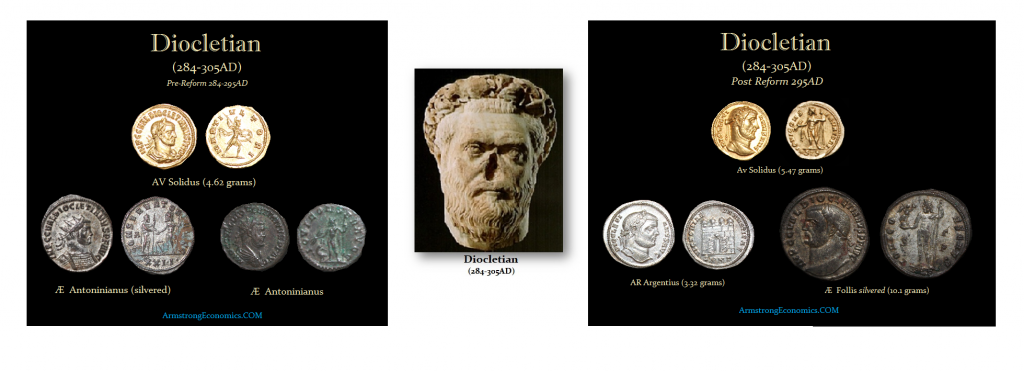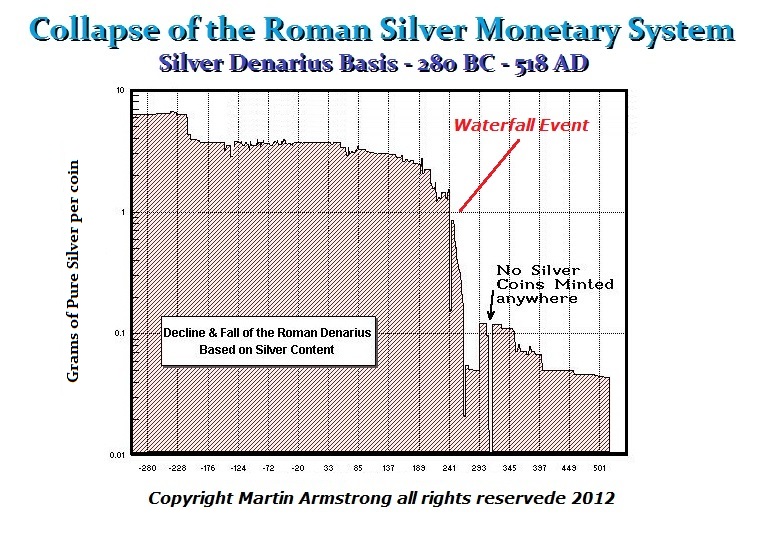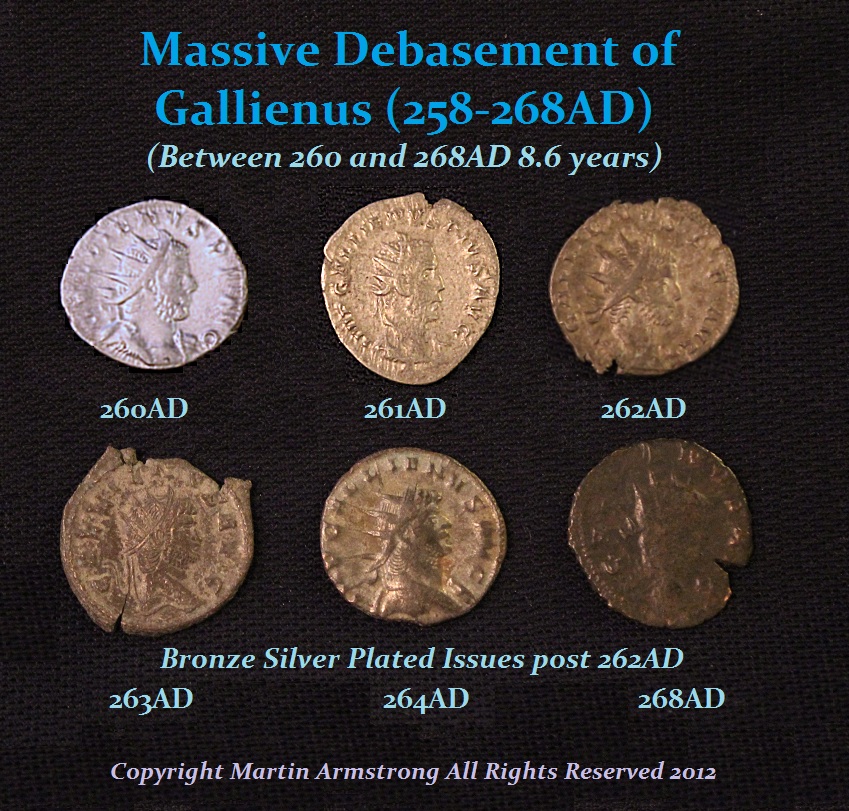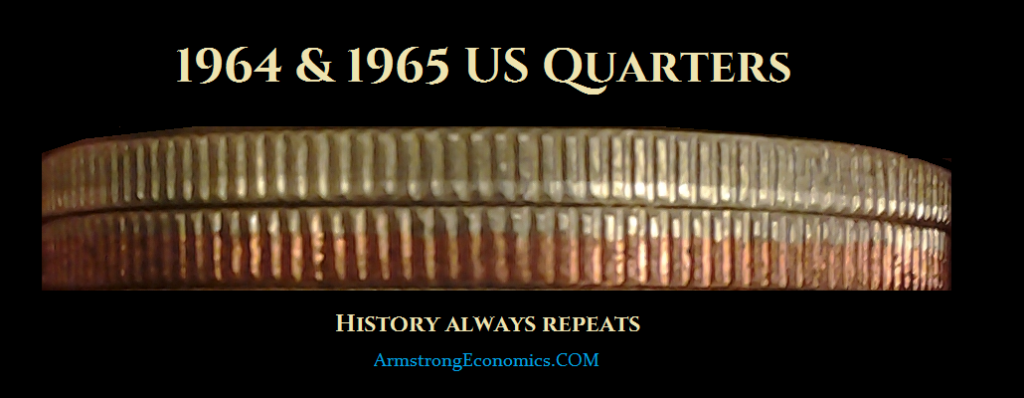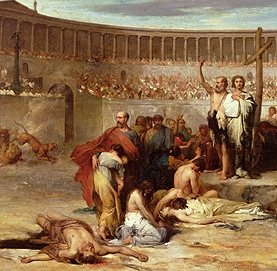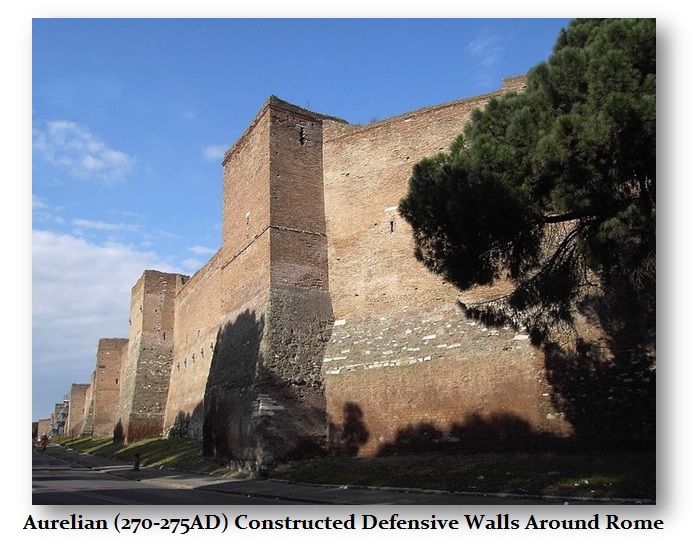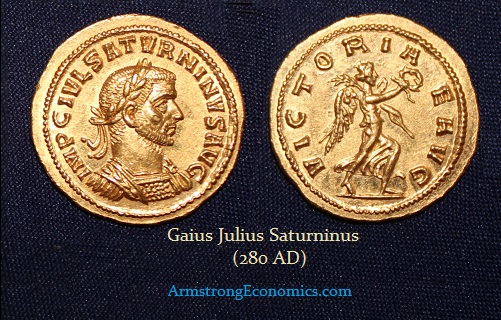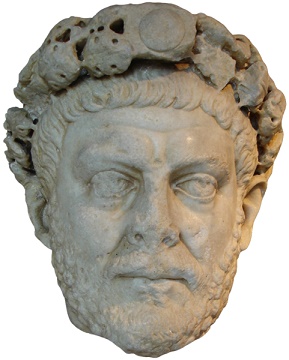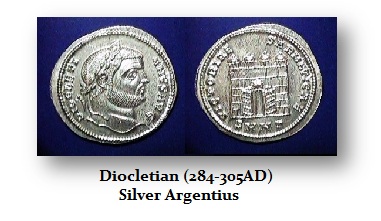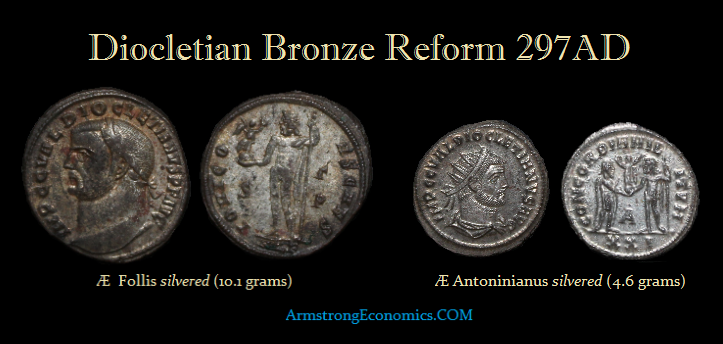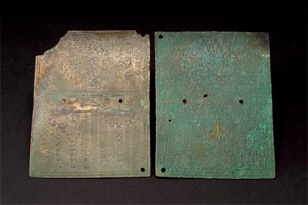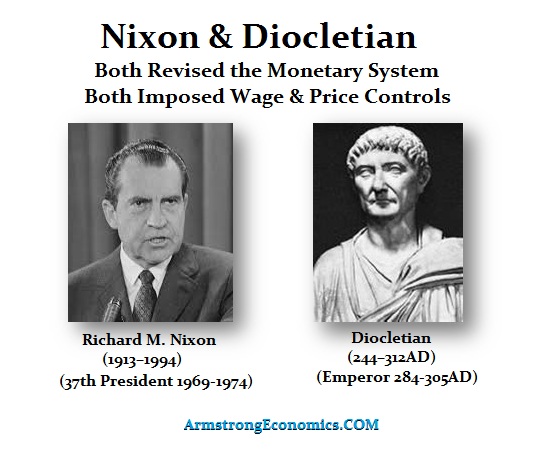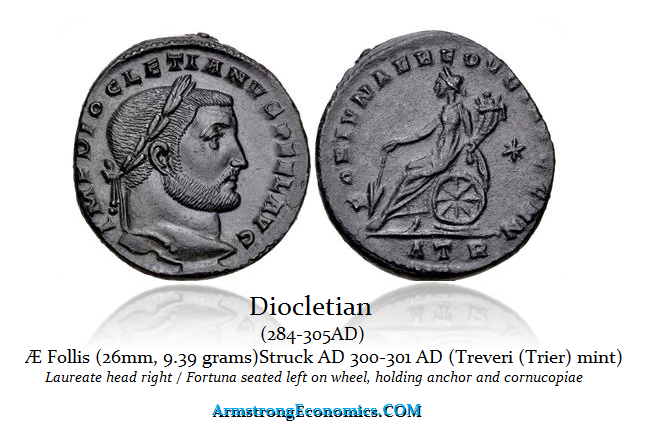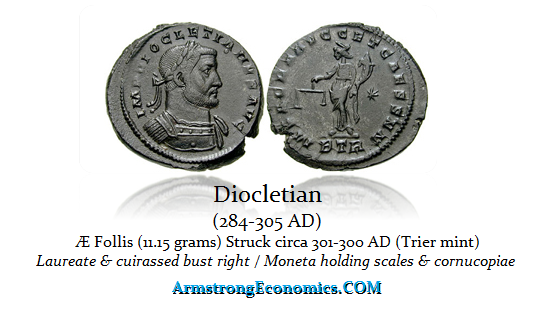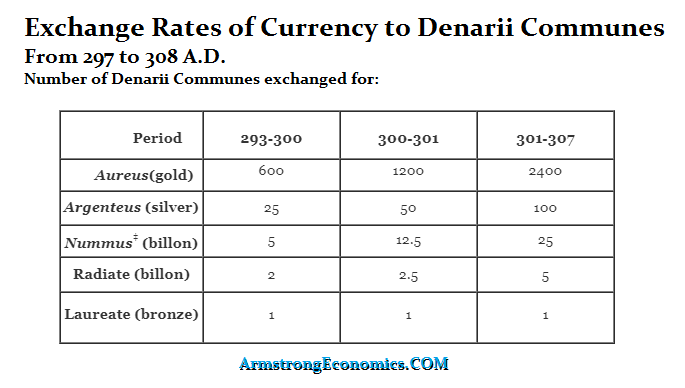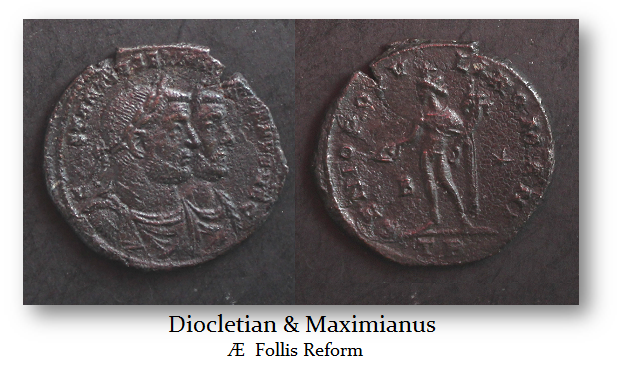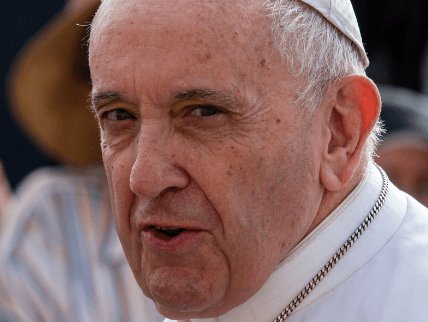QUESTION: Regarding the G7, which committed us to more stimulus, I can totally see where this is going. You are the historian. Do you not think this is where we end up – capitatio-lugatio. Same exact pattern.
Anonymous
ANSWER: For those who are not familiar with capitatio-lugatio, this was the tax collection system developed by Diocletian (284-305AD). It determines the amount levied on agriculturally productive land which was more of a wealth tax rather than income-based. This was a major tax reform following the collapse of the Roman monetary system after the capture of Emperor Valerian I (253-260AD) by the Persians. Much of his reforms still live on to this day.
Most of the historical analysis is lacking mainly because they never saw the magnitude of the collapse in the monetary system. In the course of just 8.6 years following the capture of Valerian I in 260AD and the assassination of his son Gallienus in 268AD, we can see the Antoninianus, which was largely silver in 260AD, became just a debased coin that was simply bronze chemically plated with a thin coat of silver much like our clad coinage which began in 1965.
Inflation went nuts because once the people saw that Valerian I had been captured and turned into a slave, suddenly Romans saw themselves as vulnerable. This had profound implications for it was the primary reason Christianity soared. Diocletian began fierce persecutions of Christians under the theory that the gods were angry with Rome because they would not worship them so they were punishing Rome. That is why the persecutions took place.
Then because word spread that Valerian had been captured by the Persians in the East, suddenly all the barbarians in the North began to invade believing that Rome was then vulnerable. At the same time, there was a plague. Emperor Claudius II (268-270AD) had assassinated Gallienus but then died of the plague. They called him Gothicus because he defeated the Goth invasion which brought them all the way down to Milan. This led his successor Emperor Aurelian (270-275AD) to construct the wall around Rome which was not necessary previously. Additionally, it was Aurelian who sent in the Troops into Rome to do battle with the bureaucrats running the mint who were debasing the coinage, not by official decree, but they were robbing the silver for themselves. They were then plating the bronze coins with silver which previously had been a trick of counterfeiters.
Unfortunately, the Historia Augusta (HA) which is a collection of thirty biographies of Roman emperors, co-emperors, and usurpers in chronological order from Hadrian to Carus and his sons, stops just shy of Diocletian. As usual, this was claimed to be a fraud because some of the names of emperors nobody ever heard of. But when two coins were discovered in Egypt with the name of Saturninus, these historical accounts were proven to be authentic and this became the rarest of all Roman coin that is probably worth between $5 and $10 million today (one remains in the Louver).
Claudius II Gothicus – 268-270AD
Domitianus – 268AD
Quintillus – 270AD
Aurelian – 270-275AD
Zenobla – Mother Vabalathus
Vabalathus – 271-272AD
Tacitus – 275-276AD
Florianus – 276AD
Probus – 276-282AD
Proculus (280-281AD)
Bonosus – (280-281AD)
Saturninus – (280AD)
Carus – 282-283AD
Numerian – 283-284AD
Carinus – 283-285AD
Nigrinian – Son Carinus
Julian Of Pannonia – 284-285AD
Diocletian – 284-305 AD
Amandus – 285-286 AD
Carausius – 287-293 AD
Allectus – 293-296 AD
Domitius Domitianus – 296-297 AD
Maximianus – 286-305 AD
Constantius I – 305-306 AD
Diocletian (284-305AD) was the great reformer. Diocletian completed the monetary reforms introduced by Aurelian in 274AD after he waged war on the corruption in the mint. In 286AD he began to try to fight inflation by reforming the coinage. The gold he raised the weight of the Aureus striking them at 60 to the pound raising that from 70 to the pound previously.
Diocletian then reintroduced silver coinage (argenteus) with weight and fitness which effectively reestablished the old standard from the time of Nero (54-68AD) who began the debasement.
Tetrarchy
Diocletian then turned to political reform. He is also the first Emperor to actually retire and hand power to the next in line. There were 22/23 emperors/usurpers who followed Gallienus’ assassination in 268AD. Diocletian sought to end the constant waring and split the empire between East and West and appointed a co-emperor and each had a Caesar who was to be their successor. This political structure was called the Tetrarchy. This was set up in 293AD but it was most likely following his attempts to reform the empire alone which proved to be formidable.
Finally, about 297AD he introduced a reform of the bronze coinage which he reintroduced. However, his monetary reform failed to halt price inflation. People simply hoarded the new currency, especially silver. This had the opposite effect and inflation accelerated.
Meanwhile, corresponding with the introduction of bronze coinage in 297AD, we also see that Diocletian radically restructured the tax system, in an effort to re-establish economic stability. largely by changing the property tax base and strengthening the system of perception. However, the Diocletian tax reform was carried out as early as 287AD in hopes of suspending inflation. Diocletian attempted to gain control of the chaotic usurpations of nearly 23 emperors in the 26-year period before his reign by preventing travel as we see once again with the attempt to impose COVID Passports.
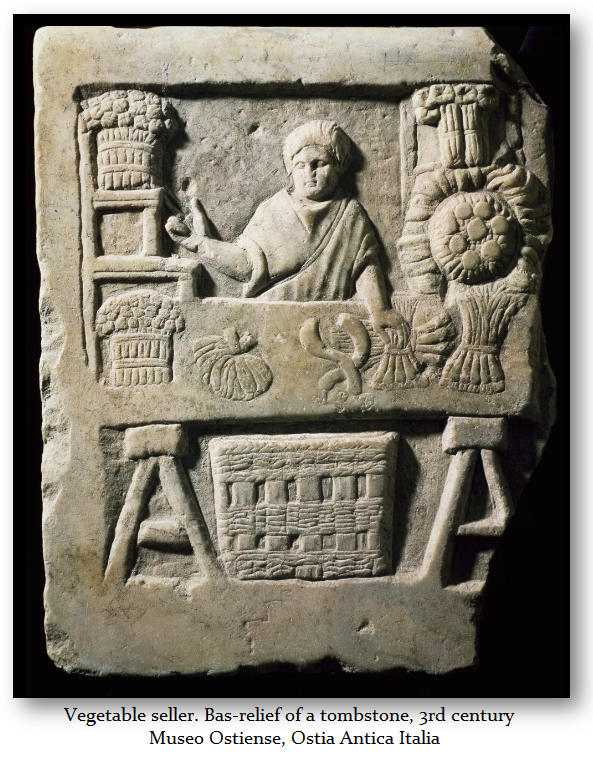 Indeed, if you were discharged from the Army you needed your papers which were really etched in bronze plates. Diocletian’s response to economic pressures and in order to protect the vital functions of the state, he restricted social and professional mobility ending the freedom of profession and the freedom of movement. Diocletian decreed that the peasants became tied to the land creating a form of serfdom. Workers in various trades such as a store-keeper, blacksmiths, public entertainers, and various bureaucrats all became occupations made hereditary. We find tomb markers depicting their trade in life.
Indeed, if you were discharged from the Army you needed your papers which were really etched in bronze plates. Diocletian’s response to economic pressures and in order to protect the vital functions of the state, he restricted social and professional mobility ending the freedom of profession and the freedom of movement. Diocletian decreed that the peasants became tied to the land creating a form of serfdom. Workers in various trades such as a store-keeper, blacksmiths, public entertainers, and various bureaucrats all became occupations made hereditary. We find tomb markers depicting their trade in life.
Even soldiers’ children were forced to become soldiers regardless of their ability all because there was then an increase in trying to recruit soldiers. This made the draft really draconian.
Diocletian also took it upon himself to restructure society and tried to resurrect and preserve the ancient virtues. He sought to obligate children to feed their parents in old age which of course was a retirement directive. Parents were directed to treat their children justly. He also ordered that spouses should end adultery and respect the laws of marriage. In matters of law, children were not to bear witness against their fathers, or slaves against their masters. In respect to private property, he upheld a creditor’s rights but also insisted that contract clauses were to be protected. He also outlawed the use of torture if truth could be discovered otherwise and encouraged governors to be as autonomous as possible. The United States is proficient at torture and simply pretends that also long as a physical mark is not left of the body then it is not torture. Threats, isolated confinement, deprivation of heat, and waterboarding are not torture in the eyes of American judges. The corruption in American courts is no different than what Diocletian forbid.
Consequently, Diocletian imposed social changes that were more totalitarian in his effort to gain control of the economy. He this also create a uniform system of taxation throughout the empire. Rome did not have income taxes. Instead, Rome had a property tax, known as the annona, which Diocletian then based on the available labor and livestock (capita) as well as after the cultivated land (iugera) calculated by tax estimates (censitores). Therefore, the assessment of taxes was based on the categories of people and animals (caput) and land (iugum) combined with each other (which mainly affected the rural population) and also subjected Italy to direct taxation, which had not been the case before Diocletian. This became what people today are calling for as a wealth tax on everything you own, but on top of your income taxes.
This system combined two pre-existing taxes, the iugatio (affecting land rents) and capitatio (affecting individuals) failed to subdue the inflation in addition to the monetary reforms. According to this methodology, the complex of arable land was divided into the various regions, according to the type of crop and their yield, into fiscal units called iuga, while the population was instead divided into fiscal units called capita. The value assigned to iuga and capita was not fixed but varied according to the individual provinces and the needs of the state budget.
Consequently, Diocletian took into account the individual performance. While contemporary authors complained, such as Lucius C. Lactantius (c. 250–325AD) who was the first Christian writer in Latin to attempt a general account of the religious history of humanity and of Rome, we must take into account that the backdrop was also the end of freedom of movement, not just religious persecutions.
The amount of tax to be paid was initially determined every five years. However, this changed to then every 15 years in 312AD. Without question, the new tax system enabled steadily flowing income, especially for the eastern part of the empire which was more secure than the West which could be easily invaded by the Germanic tribes. Diocletian tax reform merged the land and personal taxes into this single tax, the capitatio-iugatio, which was a form of wealth tax rather than income for it was based on the factors of production: men, beasts, lands. Diocletian created a massive land register of the wealth of the entire Empire.
Eventually, the Persians admired the tax reforms of Diocletian and adopted a similar tax reform in the Sassanid Empire during the 6th century. However, since the capitatio-iugatio ended up tying the peasant to the land, contributing to the training of serfs, this created what seemed to emerge as the “norm” for when Rome fell in the West in 476AD, what emerged thereafter was serfdom as the normal state of society. We see this carry forward into the 14th century which took the Black Plague to bring to an end and for capitalism to reemerge. Under this system, land without peasant labor that remained uncultivated cannot be subject to tax for it produced nothing. Therefore, the Roman government under Diocletian set in motion a structural change in society that would prevail in itself for about 600 years. With the Black Plague and the loss of 50% of the population, landlords began to offer wages for peasants to work their land.
The failure of Diocletian’s monetary reforms to suppress inflation forced Diocletian to introduce wage and price controls. We see the very same mistake that is made in modern times by the hard-money people who assume that it is the lack of a backing of the currency that leads to inflation. Here we have a major monetary reform that failed despite the restoration of silver coinage and the increase in weight of the gold aureus. Clearly, the issue was not even the quality of the money. The most profound impact leading to inflation was the collapse in confidence in government and even the power of the Roman Empire to remain invulnerable.
The Romans used the reverse side of their coinage as newspapers. Here we have Diocletian striking a coin with Fortuna who is typically pictured as holding the ancho or rudder of a ship in one hand and the cornucopia in the other. This is typically the origin of the hope for good fortune meaning on a whim she can change the course of your life like turning a rudder on a ship or give you everything you ever dreamed of. Clearly, this is something intended to inspire confidence that the “luck” of Rome is changing.
Moneta holding scales in one hand and cornucopia in the other symbolized plenty. The Roman goddess Juno Moneta (Latin Iūno Monēta) is where we derive the word “money” and also the “mint” where the money was created and flows from. As the legend goes, the Gauls attempted to invade the city of Rome quietly but had frightened the sacred flock of geese who made a lot of noise at the Temple of Juno. This alerted the Romans to the surprise attack giving us the word “monere,“ meaning “to warn” in Latin. The Temple of Juno then became popularly known as the Temple of Juno Moneta. Since this is where the coins were minted, we now arrive at the word “money” that springs from the origin of this legend and place that was an ancient mint.
Our term, such as capital flow, emerges from the Latin word “currere” meaning “to run” or “to flow.” This is where the money flowed from and gives us the word “currency” meaning the “flow of money.” This is why Juno Moneta is pictured on Roman coins as holding the balance scales in one hand and a cornucopia in the other symbolizing endless bounty or wealth. This is the birth of the terms “money” and “currency.” Diocletian is clearly suggesting that the monetary reform will restore the confidence of the ages.
In 301AD, Diocletian attempted to control inflation by issuing a maximum price edict and salaries of workers which is the same reaction that was taken by President Richard Nixon following the collapse of Bretton Woods. Diocletian’s edict has survived and it shows the same attempt to regulated wages and prices as implemented in Babylon by the Hammurabi Legal Code of 1780BC. This complied with the ECM of 242 intervals of 8.6-years. We will find the many periods in time along the way that comply with this same frequency from Solon the Lawgiver of Athens to the fall of Athens to Sparta in 404BC.
Despite all the reform efforts, the Roman Empire was collapsing because the confidence just imploded. Even the Roman officials in the periphery provinces had begun to just rule on their own taking the spoils of taxation for themselves. With the collapse in confidence and Diocletian restriction of movement, shortages in supply added to the inflation. Innovation came to a halt and commerce began to stall much as we have witnessed with the lockdowns thanks to COVID.
Once again, as the confidence in governments is collapsing and the socialistic system of endless borrowing had met a brick wall thanks to Marco Draghi taking interest rates negative in 2014, we see a very similar situation developing. While the head of state may not have been captured by the Persians, the election of Donald Trump in 2016 represented to them a usurpation of power since he was a “populist” rather than a career politician. I am not being a Trump supporter nor partisan, Career politicians simply do not want any outsider playing in their backyard. It has nothing to do with what Trump said or did not say. He was just not one of them.
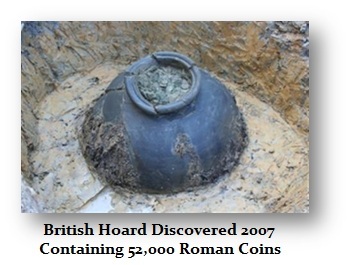 When we look closely at the events around Diocletian, we have a very similar crisis waiting for us. The social system is crashing for governments will be unable to continue to borrow at these absurd low levels of interest rates. They are cleverly planning their release of cryptocurrencies so all money can be traced and taxes collected. They too are seeking to create an identity-based accounting of all money. The cryptocurrency has been allowed to blossom with the end-game to simply seize everything and swap it for government cryptos.
When we look closely at the events around Diocletian, we have a very similar crisis waiting for us. The social system is crashing for governments will be unable to continue to borrow at these absurd low levels of interest rates. They are cleverly planning their release of cryptocurrencies so all money can be traced and taxes collected. They too are seeking to create an identity-based accounting of all money. The cryptocurrency has been allowed to blossom with the end-game to simply seize everything and swap it for government cryptos.
Today, and in the 3rd century, people have been hoarding their money until Biden took office and inflation has begun to rise. This is why inflation did not appear despite the rising supply of money because people did not trust the future post-2008. The collapse in real estate back then really upset the average person who regarded that as their retirement. We find massive hoards of even debased coins from the 3rd century provide it was not even the metal content. With barbarians at the Gates, people simply did not spend money leading to deflation and the economic decline. When Diocletian came to power and introduced all of these reforms, that is when we begin to see inflation rise sharply.
Perhaps most important concerning Diocletian’s program of domestic reform, he clearly followed some of the leads of his predecessors who had made some tentative attempts in the same direction of reforms. The emperor Gallienus had excluded senators from the army and separated the control of the military from civil careers. The Senate had progressively been deprived of its privileges in an effort to reduce its power. Diocletian recognized this same trend and structurally arranged the government in such a manner that led toward the centralized control that put all powers at his disposal. We see the very same strategy to end democracy unfolding today.
Diocletian designated the consuls to watch over the affairs of the state and distanced the senators from any collaboration with respect to making the laws. Today, we have the structure of the European Union whereby the people can vote for the Parliament, but they have no power to create law – that is done by the Commission which never stands for election. Klaus Schwab’s World Economic Forum is pushing this very same structure to eliminate elections and reduce them at best to symbolic.
We also see that Diocletian used bureaucrats, unelected actors, as imperial counselors (consilia sacra) which he appointed to run specialized offices with their loyalties to his administration – not the senate. He expressly defined the power of the praetorian prefects (personal bodyguards to the emperor) and limited that for this is where often usurpers arose. The number of bureaucrats increased dramatically under Diocletian. Over the next 50 years, it would often be said that there were more people in government than there were paying taxes. This was the beginning of the bureaucracy and technocracy that was eventually overrun the empire and became excessive under Byzantium rule. This is once again emerging here in modern times as there is always an expansion of government for the more the economy declines, the more power they try to claim to maintain that power.
Diocletian even reorganized the army sending the local troops to the frontier and the main movable army was made domestic. He also increased the size of the army Troop strength was increased by a fourth (not multiplied by four as Lactantius claims). There too, Diocletian’s reforms became our norm whereby he exempted soldiers from duty after 20 years of service which became our standard for retirement into modern times.
It appears that these reforms did manage to create some short-term financial stability. However, the rise of Constantine I the Great following his father’s death, who was an heir in line for succession, led to the collapse of the political reforms. Constantine, which mother was a Christian, promoted Christianity for political purposes saying that there is one God and there should be one Emperor – in heaven as on earth.
History is repeating. The monetary reforms they have planned are slowly being leaked out drip by drip because they know they will never get the people to support it. This virus has been exploited for political gain to shut down the movement of the people as was the case with Diocletian. They are seeking to centralize power in a one-world government once again and the outcome of this will be the same – war. History repeats because human nature never changes and the ideas that emerge are just like watching the same movie day after day.

